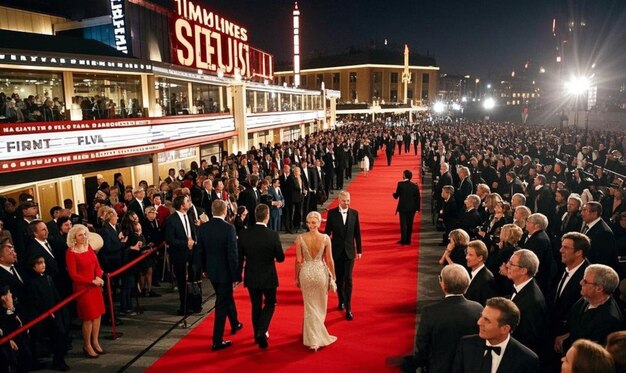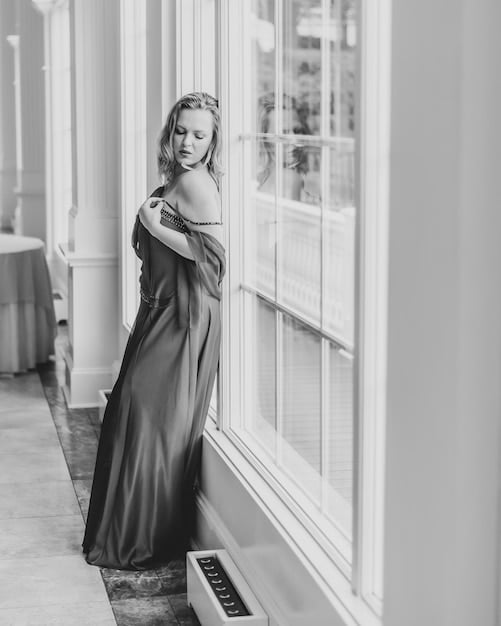Decoding Red Carpet Fashion: Evolution and Trends in American Style

Decoding the American Red Carpet fashion involves understanding its evolving trends, influence on broader fashion, and the cultural statements made through celebrity attire, offering a glimpse into the ever-changing landscape of style and societal values.
Decoding the Dress Code: Navigating the Evolving Landscape of American Red Carpet Fashion is an intriguing journey through the glamorous world where celebrities make iconic statements. From classic elegance to avant-garde expressions, the red carpet has become a dynamic reflection of American culture and fashion trends.
The Historical Roots of Red Carpet Fashion
The red carpet wasn’t always synonymous with high fashion. Its evolution is deeply intertwined with the history of Hollywood and the increasing importance of celebrity image.
Understanding the historical context helps appreciate how the red carpet transformed from a functional pathway to a global fashion stage.
Early Hollywood Glamour
In the early days of Hollywood, red carpets were more about functionality than fashion statements. They served as a literal path for stars to enter movie premieres and events.
However, even then, the seeds of glamour were being sown as actresses like Marlene Dietrich and Joan Crawford began to influence style through their on-screen and off-screen appearances.
The Rise of the Studio System
The studio system played a significant role in shaping early red carpet fashion. Studios carefully crafted the image of their stars, often dictating what they wore to maintain a consistent brand.
This control extended to red carpet appearances, where stars were expected to embody the elegance and sophistication promoted by their studios.
- Controlled Images: Studios managed every aspect of a star’s appearance, including their wardrobe.
- Promotional Tool: Red carpet events were used to promote films and enhance the star’s public image.
- Limited Individuality: Stars had little freedom to express their personal style, adhering to studio-approved looks.
The shift from utilitarian function to a promotional platform marked a pivotal moment in red carpet history. As Hollywood’s influence grew, so did the red carpet’s significance in the world of fashion.
The Golden Age of Hollywood: Setting the Standard
The Golden Age of Hollywood cemented the red carpet’s reputation as a place of unparalleled glamour and style. The era saw the emergence of iconic looks that continue to influence fashion today.
Stars like Audrey Hepburn, Grace Kelly, and Marilyn Monroe defined elegance, sophistication, and allure, setting standards that designers and celebrities still strive to emulate.
Iconic Looks and Designers
During the Golden Age, certain looks and designers became synonymous with red carpet glamour. The collaborations between stars and designers created unforgettable moments in fashion history.
For instance, Audrey Hepburn’s collaborations with Hubert de Givenchy epitomized chic simplicity, while Marilyn Monroe’s figure-hugging gowns showcased her iconic curves.
Influence on Fashion Trends
The fashion showcased on the red carpets of the Golden Age had a profound impact on broader fashion trends. What stars wore often trickled down to everyday wear, influencing what people aspired to wear.
The elegance and sophistication of the era set a high bar, inspiring designers and consumers alike.

- Timeless Elegance: The emphasis on classic silhouettes and refined details.
- Designer Collaborations: The partnerships between stars and designers shaping fashion trends.
- Enduring Influence: The lasting impact of Golden Age fashion on contemporary style.
The Golden Age not only set the standard for red carpet fashion but also demonstrated the power of celebrity influence on broader cultural and style trends. The legacy of this era continues to resonate in modern red carpet moments.
The Rise of Celebrity Stylists and Fashion Houses
The modern red carpet scene is heavily influenced by celebrity stylists and renowned fashion houses. These players have reshaped how stars present themselves and the impact of their fashion choices.
The collaboration between stylists and fashion houses has transformed the red carpet into a strategic platform for both personal branding and global fashion promotion.
The Role of Celebrity Stylists
Celebrity stylists have become indispensable figures in the fashion industry. They curate looks, manage relationships with designers, and ensure their clients make a statement on the red carpet for events.
Stylists like Law Roach and Rachel Zoe have become celebrities in their own right, known for their innovative and trendsetting choices.
Strategic Partnerships with Fashion Houses
Fashion houses leverage the red carpet as a prime marketing opportunity. They offer exclusive designs to celebrities, knowing that the exposure can significantly boost their brand image.
These partnerships are often strategic, with designers carefully selecting celebrities who align with their brand aesthetic and values.
- Brand Alignment: Fashion houses choose celebrities who represent their brand’s identity.
- Exclusive Designs: Celebrities often wear one-of-a-kind pieces created specifically for the event.
- Media Exposure: The red carpet provides unparalleled media coverage for both the celebrity and the designer.
The influence of celebrity stylists and strategic partnerships with fashion houses has elevated the red carpet to a high-stakes game, where every outfit choice is meticulously planned and executed for maximum impact.
Cultural and Social Impact of Red Carpet Fashion
Red carpet fashion extends beyond mere aesthetics; it often serves as a platform for cultural statements and social commentary. Celebrities use their outfits to express opinions, support causes, and challenge norms.
Understanding the cultural and social dimensions of red carpet fashion reveals how it reflects and influences broader societal values and trends.
Fashion as a Form of Activism
In recent years, celebrities have increasingly used their red carpet appearances to make political and social statements. Outfits can convey messages of solidarity, protest, and advocacy.
For example, wearing a specific color to support a cause or choosing designs from marginalized communities are ways celebrities use fashion to amplify their voices.
Challenging Norms and Stereotypes
The red carpet has also become a space for challenging traditional norms and stereotypes. Celebrities are pushing boundaries with gender-fluid looks, diverse body representations, and unconventional styles.
These choices not only showcase individuality but also promote inclusivity and acceptance.

- Political Statements: Using fashion to express support for social and political causes.
- Breaking Boundaries: Challenging traditional gender and beauty norms.
- Promoting Diversity: Showcasing a range of body types and cultural representations.
The cultural and social impact of red carpet fashion underscores its role as more than just a display of beautiful clothes. It’s a dynamic forum for expressing values, driving conversations, and shaping societal perceptions.
Trends and Innovations in Red Carpet Style
The landscape of American red carpet fashion is continually evolving, driven by emerging trends and technological innovations. These changes are shaping the future of red carpet aesthetics and practices.
Staying abreast of these trends and innovations is crucial for understanding where red carpet fashion is heading and how it will continue to influence broader style narratives.
Sustainable and Ethical Fashion
Sustainability is becoming an increasingly important consideration in red carpet fashion. Celebrities and designers are embracing eco-friendly materials, vintage pieces, and ethical production practices.
This shift reflects a growing awareness of the environmental and social impact of the fashion industry.
Technological Advancements
Technology is also playing a significant role, with innovations like 3D-printed garments, interactive dresses, and digital fashion experiences making their way onto the red carpet.
These advancements are pushing the boundaries of what’s possible in fashion design and presentation.
- Eco-Friendly Materials: Using sustainable fabrics and recycled materials.
- Vintage Revival: Promoting the reuse of vintage and pre-owned garments.
- Digital Fashion: Incorporating technology into designs for interactive and innovative looks.
As sustainable practices gain momentum and technological advancements continue to unfold, the red carpet is poised to become a hub for forward-thinking and environmentally conscious fashion. These changes will further amplify the cultural and social impact of the red carpet on society.
Future of Red Carpet Fashion
The future of American red carpet fashion promises even more innovation, inclusivity, and impact. As technology evolves and societal values shift, the red carpet stages will continue to reflect and shape the cultural zeitgeist.
The fusion of personal expression, social responsibility, and cutting-edge technology will define the next era of red carpet glamour.
Increased Personalization and Individuality
The future red carpet will likely see even greater emphasis on personal style and individuality. Celebrities will have more freedom to express their unique identities through fashion, breaking away from rigid norms.
Expect to see more personalized designs, custom-made pieces, and unconventional styling choices that reflect the diverse personalities of the stars.
Enhanced Digital Engagement
Digital engagement will play an increasingly crucial role, with virtual red carpets, augmented reality experiences, and interactive fashion shows becoming more common.
These innovations will allow fans to engage with red carpet fashion in new and exciting ways, fostering a stronger connection between celebrities, designers, and audiences.
- Virtual Red Carpets: Digital events that extend the reach of red carpet fashion to a global audience.
- Augmented Reality: Enhancing the red carpet experience with interactive digital elements.
- Direct Fan Engagement: Allowing fans to participate in the red carpet experience through social media and virtual platforms.
The future of American red carpet fashion is set to be a dynamic and inclusive space, where personal expression, social impact, and technological innovation converge to create truly memorable moments. The red carpet will likely become a beacon of cultural creativity and a leading indicator of broader fashion trends.
| Key Point | Brief Description |
|---|---|
| 🌟 Historical Evolution | Traces the red carpet’s transformation from functional pathway to fashion stage. |
| 👗 Golden Age Glamour | Highlights iconic looks and designers that set lasting standards |
| 🌍 Cultural Impact | Examines fashion as activism and a means to challenge norms. |
| 🌱 Sustainable Trends | Covers rise of eco-friendly materials and ethical practices. |
Frequently Asked Questions
▼
Red carpet fashion is important because it sets trends, influences broader fashion, showcases designers’ creativity, and provides a platform for celebrities to express themselves and make cultural statements.
▼
Celebrity stylists have revolutionized red carpet fashion by curating looks, managing relationships with designers, and ensuring their clients make memorable fashion statements that reflect personal brands.
▼
Fashion houses leverage the red carpet as a prime marketing opportunity to promote their designs and enhance their brand image by dressing celebrities in exclusive pieces for high-profile events.
▼
Technology is transforming red carpet fashion through innovations like 3D-printed garments, interactive dresses, and digital fashion experiences, pushing the boundaries of design and enhancing audience engagement.
▼
The future of red carpet trends includes prioritizing sustainable fashion, embracing technological advancements, and promoting increased personalization and individuality to amplify cultural statements.
Conclusion
In conclusion, decoding the dress code: navigating the evolving landscape of American red carpet fashion reveals a rich and dynamic world, influenced by history, culture, and innovation. From the Golden Age of Hollywood to the rise of celebrity stylists and the embrace of sustainable practices, the red carpet continues to evolve, shaping not only fashion trends but also broader societal values. The future promises even greater personalization, digital engagement, and impactful cultural statements, solidifying the red carpet’s role as a key influencer in the global fashion narrative.





